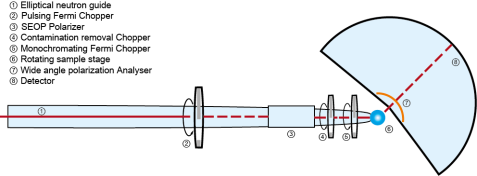MLZ is a cooperation between:
 > Technische Universität München
> Technische Universität München > Helmholtz-Zentrum Hereon
> Helmholtz-Zentrum Hereon
 > Forschungszentrum Jülich
> Forschungszentrum Jülich
MLZ is a member of:
 > LENS
> LENS > ERF-AISBL
> ERF-AISBL
MLZ on social media:

MLZ (eng)
Lichtenbergstr.1
85748 Garching
TOPAS (under construction)
Thermal time-of-flight spectrometer with polarization analysis
TOPAS will be a thermal time of flight spectrometer featuring polarization analysis. It is optimized for high flux and good energy resolution.
It features a 45 m elliptic neutron guide, which focuses the neutrons onto the sample in the new eastern neutron guide hall. The guide is designed to provide an intense neutron beam at the sample, and to keep the background low, which can arrive in the experimental area.
A beam stop at the centre of the ellipse blocks the direct line of sight to the reactor and a small
The chopper system consists of two Fermi choppers, which provide very short neutron pulses even for large neutron windows, which are a consequence of the elliptic neutron guide. We emphasize, that the Fermi choppers also provide high repetition rates up to
An additional disk chopper removes contamination pulses of unwanted neutron velocities.
The neutron beam can be polarized by a continuously operated spin exchange optical pumping 3He filter cell, which provides a constant polarization efficiency.
The final choppers and the flight path volume haven’t any window to keep parasitic scattering low. The vacuum system is designed to reach cryogenic vacuum to allow low temperature applications without additional neutron windows. The volume around the sample can be separated from the rest of the flight path volume for the exchange of the sample or sample environment.
The sample can be rotated by 360º to map the full dispersion relation in single crystalline materials.
The TOPAS detector consists of 289
- Mapping of coherent excitations in correlated electron systems, particularly magnetic excitations.
- Measurement of the density of phonon states to probe the molecular dynamics in molecular solids.
- Investigation of limited size and reduced dimensionality effects on the dynamic in nanoparticles.
- Investigation of proton dynamics hydride materials for energy applications.
For many of the intended instrument applications polarization analysis will provide unique opportunities e.g. for the study of magnetic excitations or the separation of the spin incoherent scattering in hydrogen containing materials.
Primary Beam
- Beam Port: SR5m
- Chopper system: 2 Fermi choppers, 1 Disc chopper
- Chopper Frequency range:
200 – 600 Hz - Neutron guide cross section in-pile:
15 x 50 mm2 - Maximum neutron guide cross section:
81 x 121 mm2 - Neutron guide cross section in front of 2nd Fermi chopper:
23 x 44 mm2
Experimental parameters
- Incident wavelength range: 0.8 – 3 Å
- Energy transfer range: -120 – 50 meV
- Elastic energy resolution: 4 – 6 %
- Horizontal divergence: ±0.75º
- Vertical divergence: ±0.75º
- Detector coverage: -30º – 5º, 5º – 150º
- Simulated monochromatic neutron flux:
5 × 105 n/cm2s
Operated by

Publications
Find the latest publications regarding TOPAS in our publication database iMPULSE:
MLZ is a cooperation between:
 > Technische Universität München
> Technische Universität München > Helmholtz-Zentrum Hereon
> Helmholtz-Zentrum Hereon
 > Forschungszentrum Jülich
> Forschungszentrum Jülich
MLZ is a member of:
 > LENS
> LENS > ERF-AISBL
> ERF-AISBL
MLZ on social media:




